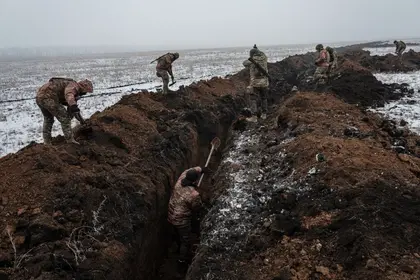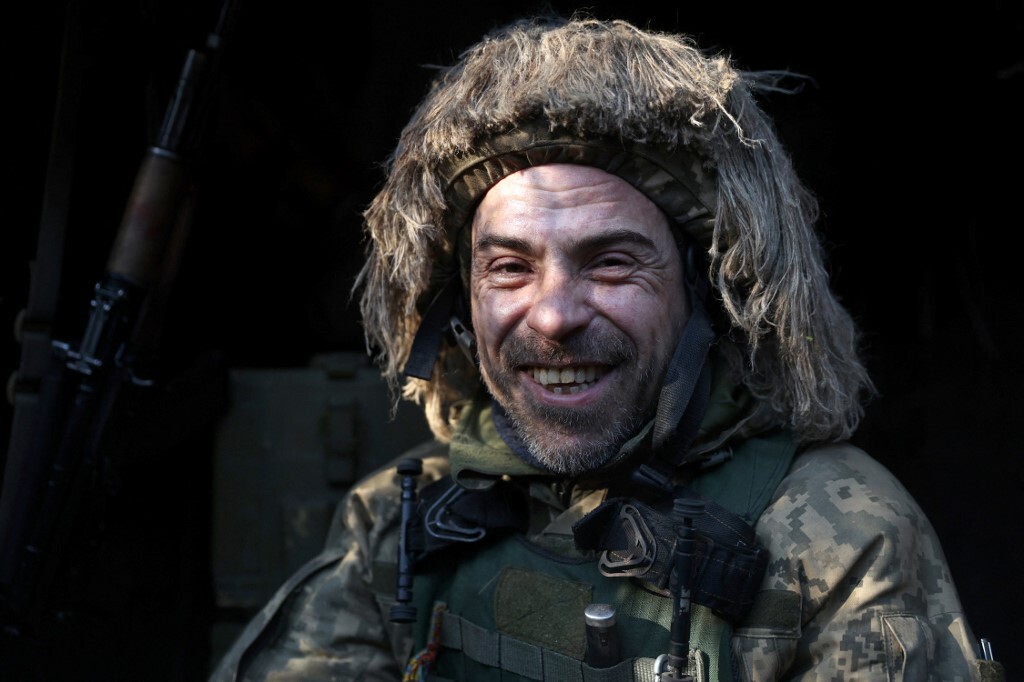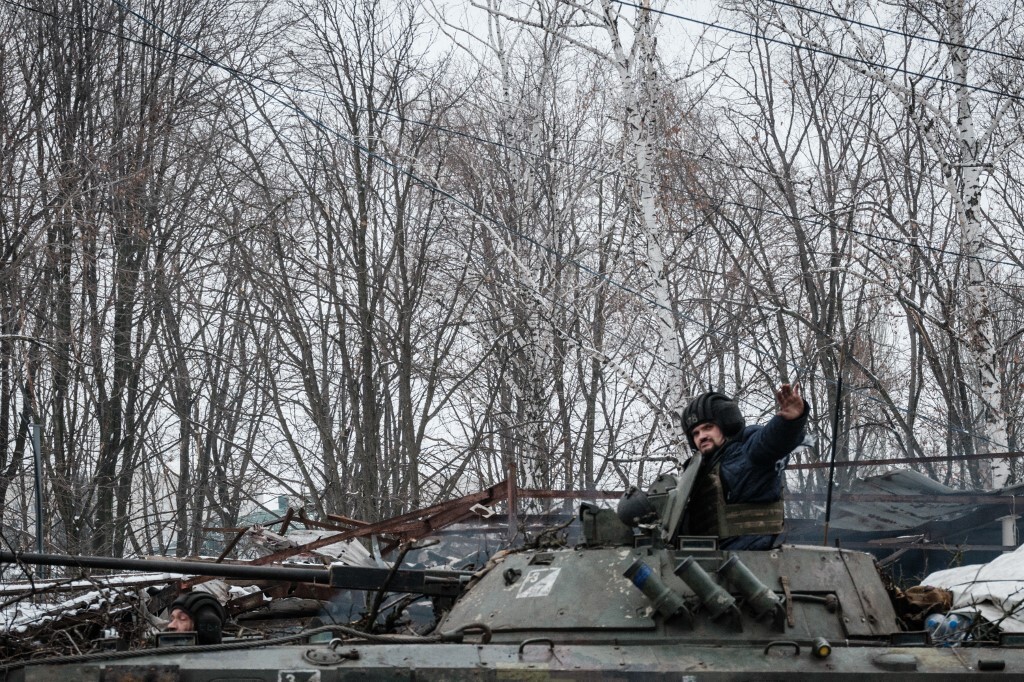In macabre-like fashion, the war in Ukraine is devolving ever deeper into an unending abyss of death and destruction. Haunted early on by Russian crimes against humanity and civilian mass graves in Bucha and Izyum, this violent dance of death between Ukrainian and Russian soldiers is now, for a while, largely playing out in the fields and streets in and around Bakhmut and Kreminna – and elsewhere in the Donbas.
- View the freshest war in ukraine update in the Kyiv Post’s daily news pieces that came out today.
- Look at the latest Ukraine news that was released today.
Chatter and rumors of impending military offensives abound on both sides. Yet presently, the fighting and the killing is mainly occurring in blood-filled trenches that could have been plucked from history off the battlefields of the Somme in World War I. It is a weird war, and it is a war whose sinister tales are getting weirder.
It is, in many respects, as though all of the elements of the classic 1970s DC Comics series “Weird War Tales” are coming together. Death, destruction, horror, and suspense – and even elements of science fiction as NATO slowly, but increasingly rolls out decisive game-changing technologies on the battlefield, including High Mobility Artillery Rocket System (HIMARS) and the dynamic Ground Launched Small Diameter Bomb (GLSDB).
It is also a weird war that is replete with Call of Duty-like zombies with Wagner Group mercenaries filling the title role. Erin Burnett, host of CNN’s OutFront, reported that Yevgeny Prigozhin’s forces are likely fighting in the trenches of Kreminna while juiced on drugs. That would explain their willingness to keep dying in human-wave after human-wave attacks against Ukrainian fixed positions.

Diane Francis Interviews Mikhail Zygar, Yaroslav Trofimov on Prospects of Russia’s War on Ukraine
If either side is to break free of this Hell, then a successful spring (if not sooner) counteroffensive will be required. Politically speaking, Russian President Vladimir Putin is under the greatest pressure to deliver a victory. We are now approaching the one-year anniversary of his “special military operation.”
Before the thaw
Feb. 24, however, is simply a day on the calendar. Terrorists tend to obsess about dates, not defense ministries. The looming spring season on the other hand, brings warmer weather and the threat of thawing Ukrainian plains, which would limit off-road mobility for tanks, artillery, and armored personnel carriers. Military convoys clogged and lined up on roads present excellent targets for Ukrainian soldiers armed with Javelins and drones – as the Kremlin learned firsthand and at great cost during the failed assault on Kyiv.
Muddy fields notwithstanding, Putin may be forced to accelerate his planning and move Moscow’s timeline forward. Increasingly in the months ahead, Ukraine will become militarily stronger, especially from a combined offensive force standpoint. The weapon systems and ammunition, including the Leopard 2 and M1 Abrams main battle tanks (MBT), pledged by NATO are indeed formidable – and potentially decisive.
Ukraine’s new MBTs could be on the battlefield in as little as “3 to 6 weeks,” and Ukrainian soldiers begin training next week in Germany and Poland. That would mean an estimated time of arrival on the battlefield as soon as March 18. Given this quickly closing window, it is unlikely Russia would wait, let alone accommodate, a train-up period and deployment of the Leopard 2 MBTs to the front lines without first launching a preemptive strike.
But is Russian General Valery Gerasimov and his severely wounded Russian military capable of launching an offensive in late-February or early March? The short answer is yes, but it will be ugly. Particularly because of the greatly diminished quality of Russian troops available to him.
Weakened Russian forces
Putin’s losses of men in Ukraine, to date, are horrific. Now 11 months into sustained combat operations, 131,000 Russian soldiers have been killed in action, many of whom were from Russia’s most elite, best trained, and equipped units. Factoring in the historical wounded-in-action to killed-in-action ratio of 3:1, upwards of an additional 384,000 Russian soldiers have likely been removed from the battlefield.
The Kremlin simply cannot easily or quickly replace these formations with mobilized reservists and conscripts. They can put uniforms on them, but that does not make them trained combat ready soldiers. It does, however, make them easy targets for Ukrainian artillery.
The remains of a once formidable Russian army, at best, is a pick-up game of personnel and equipment that is devoid of the junior officer and noncommissioned officer leadership necessary to lead the fight. Replacing generals and colonels cannot change that reality. This will significantly limit Russia’s options for any spring offensive.
Ostensibly, by default, the new game plan will be more of the same. Bloody attrition warfare simply spread to new battlefields in towns like Vuhledar, Mykolaivka, Sakko i Vantsetti, and Bilohorivka. Only the faces of the Russian soldiers doomed to refight a modern-day version of the Battle of the Somme will have changed.
There is an adage that comes to mind when you consider the current state of the Russian military in Ukraine. “You play to your strength.” Right now, Moscow is reduced to two of the nine principles of war described in U.S. Army Field Manual 100-5: Operations: mass and simplicity.
In terms of mass, as we have already witnessed on the battlefields around Bakhmut and Soledar, that comes down to infantry, artillery and relentless human-wave assaults designed to exhaust and overwhelm the defending force, but at a significant cost. A cost Putin is clearly willing to pay now, and in the foreseeable future. Ukrainian Defense Minister Oleksii Reznikov underscored the Kremlin’s reliance on mass when he told French media on Wednesday that Russia had as many as 500,000 troops ready for an attack. But where? Reports from Mariupol from suggest Russian troops have begun to stage there – as many as 30,000.
Russia’s game plan
Simplicity dictates the Kremlin must think small. Militarily defeating Ukraine conventionally is likely beyond Putin’s reach, but holding on to the pre-Feb. 24 lines in the Donbas and securing the land bridge to Crimea are, conceivably, within the realm of possibility.
If ordered, the Russian offensive would likely take place along three lines of effort: north, east, and south. In the north, Russian forces, together with Belarusian counterparts, would likely, in U.S. Army Field Manual (FM 1-02.11) operational terms, “demonstrate” a credible offensive capability to threaten the capital city of Kyiv in a supporting effort. To some extent, the Joint Military Group in Belarus is already executing this mission.
This demonstration would continue to hold a sizable Ukrainian force to defend the border region and the avenues of approach into the city. In the south of Ukraine, a second supporting effort would involve Russian ground forces attacking to operationally “seize” territory up to the Dnipro River in the Kherson Oblast. This would emplace a daunting terrain feature between Ukrainian and Russian occupied territory. Retaining this land mass would “secure” the Crimean Peninsula, the Sea of Azov, and access to the Black Sea.
The main Russian effort, however, would likely unfold to the east, in the Donbas region. Russian ground forces would attack to seize the Luhansk and Donetsk Oblasts. According to Ukrainian Military Intelligence representative Andriy Chernyak, speaking to Kyiv Post, Putin ordered the Russian military to capture Donetsk and Luhansk Oblasts by March. If Russian ground forces can obtain these objectives, Putin may be content, for now, to declare a victory, and get the U.S. and NATO to pressure, if not force, Zelensky to the negotiation table.
Will it work?
While this briefs well as a strategic approach, it is likely Gerasimov does not have enough maestro in him or in his staff to pull it off, or at least not any time soon. Losses in equipment, personnel and combat experience are continuing to take a toll on Russian morale and combat effectiveness. Further, there is dissention deep within the ranks.
Nor is Putin making Gerasimov’s job any easier. By pitting Prigozhin and his Wagner Group mercenaries against Russian Defense Minister Sergei Shoigu’s military forces against each other in the Donbas, the Russian president is making this war even weirder and far more difficult for Moscow to win. Instead of combining forces to target Ukrainians and work together to affect the fall of Kreminna and Bakhmut, they are failing to act in concert and protect each force’s flanks from Ukrainian counter attacks – they lack a key principle of war, “unity of command.”
Russian military dysfunction has been on display since day one. As a result, turrets, once attached to the most sophisticated tanks in the world, have been detached from their chassis and now litter the fields of Ukraine. Putin’s military has been reduced to pulling T-62 tanks out of storage and resorting to Iran, North Korea and Belarus for drones, ballistic missiles, tanks, ammunition, training, winter clothing and field hospitals.
Moreover, one of Russia’s few strengths could soon prove to be a liability. To date, the Russian army has proven very effective in attacking static defensive positions as evidenced in Soledar and Mariupol. Artillery bombardments and frontal human wave assaults afford them a few hundred meters a day. Ukraine, however, is not likely to remain static, and with the training, equipment, and intelligence provided to them by the U.S. and NATO, Kyiv will be able to outmaneuver Russian ground forces, who have not exhibited an ability to defend well.
Further, while no plan survives contact, the scripted nature of Russian warfare does not afford initiative. Moscow’s mantra is overly simplistic. Continue moving forward, whatever the cost. One Ukrainian soldier fighting in Bakhmut described the battle like a scene out of a zombie movie: “We were fighting for about 10 hours in a row. And it wasn’t like just waves, it was uninterrupted. So, it was just like they didn’t stop coming.”
Undoubtedly, a dark red Russian storm will soon be descending on Ukraine. However, Kyiv is not without its own advantages. Masking the positioning of 500,000 Russian soldiers and equipment will be a challenge. Movement will be clumsy and observable by Ukrainian and Western intelligence.
Zelensky’s biggest challenge is that the majority of Russia’s counteroffensive forces will remain outside the borders of Ukraine, either in sanctuary, or beyond the range of Guided Multiple Launch Rocket System (GMLRS) in Belarus, Rostov and Sevastopol. Indicators will abound, including troop and equipment movement by rail, ship, convoy, and heavy equipment transport (HET), forward positioning of field hospitals, establishment of refueling points, ammunition holding areas and supply depots, formation of artillery groups, deception, and the absence of “chatter” on internet calls and social media platforms like Telegram.
Ukraine can also anticipate probing along the fronts in Kherson, Luhansk, and Donetsk Oblasts to identify weak points in Ukrainian defenses for exploitation, and testing of air defense networks with drones to locate key weapon and radar sites for future targeting. In addition, Wagner Group mercenaries will likely be repositioned to the supporting effort in the south to deemphasize Prigozhin’s success and minimize interaction with the Russian Army.
Kyiv can expect artillery, cruise missile and drone strikes will initiate the offensive, only this time residential neighborhoods will be replaced with the capital city, governance, military headquarters, troop formations, communication nodes, the electrical grid, and key weapon systems they can identify. Zelensky and HIMARS, undoubtedly, will top that list. The goal will be to either decapitate or blind Ukrainian leadership, cut off communications, and set conditions for the ground assault. Mass and simplicity, slow and deliberate – relentless pressure. 500,000 warm Russian bodies disguised as soldiers and a complete disregard for human life, be it Russian or Ukrainian.
No time to waste
The U.S. and NATO can no longer wait for optimal conditions on the ground to introduce new weapon systems and munition suites that can enable Ukraine to more effectively maneuver and interdict Russian forces. Kyiv must not be forced into fighting from a static defense. Waiting for the fight to come to them is not an option. Let Russia refight the Somme. Ukraine is deserving of fighting in the 21st century.
The Russian military has proven it has difficulty hitting moving targets, so Kyiv must play to its strength. Ukraine must maneuver, thereby dictating their own terms on the battlefield, and fight in locations of their choosing and making Russia react to their movements. That also means hitting Russian targets before they can arrive on active battlefields, affording no sanctuary and no quarter. The battle cannot be contained to just within the borders of Ukraine – it extends to Russian presence and threat.
This is not a Call of Duty game. Putin’s zombies are very real, and they are increasingly coming out of his shadow to kill Ukrainians. Moreover, the Kremlin is not likely to wait for the latest $2 billion tranche of military aid from the U.S. to reach Ukraine. The need is now because the crucial fight for Ukraine’s survival and independence is now.
President Biden continues to convey to Zelensky and our NATO partners the same message: “The United States, standing shoulder-to-shoulder with our Allies and partners, is going to continue to do all we can to support Ukraine… to defend its sovereignty and territorial integrity.” That is true, but Biden needs to understand that sometimes the best defense is a strong offense. Especially against a faltering Russian military. It is time for NATO to empower Ukraine to go on the offensive. Zelensky and his fellow Ukrainian citizens have more than earned that right.
All is not quiet on the eastern front in Ukraine. It is getting very, very loud and this weird war is about to get even darker.
The opinions expressed in this article are the authors’ and not necessarily those of Kyiv Post.
You can also highlight the text and press Ctrl + Enter








